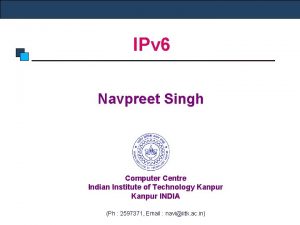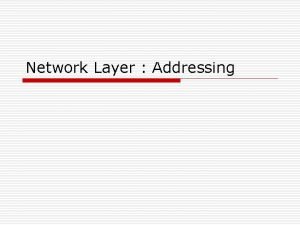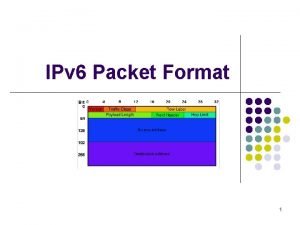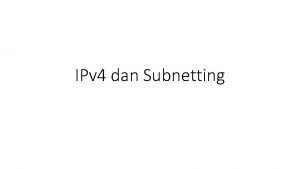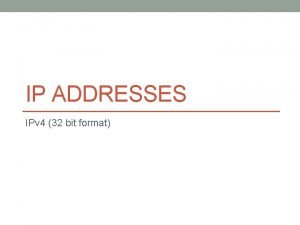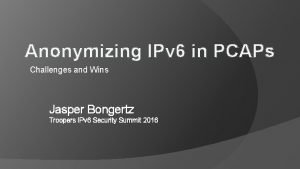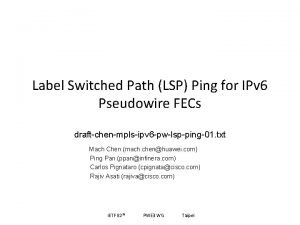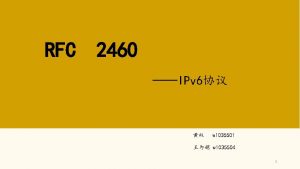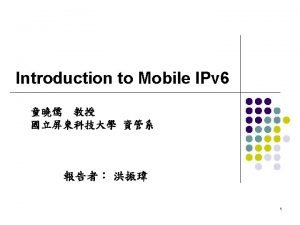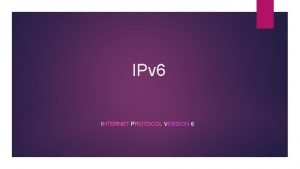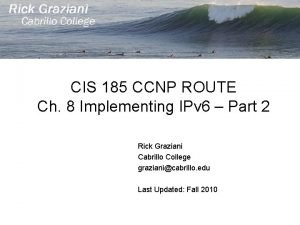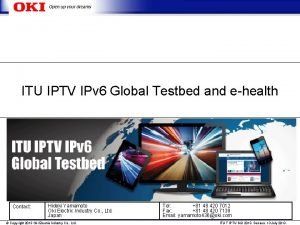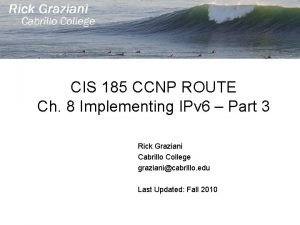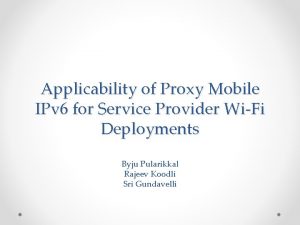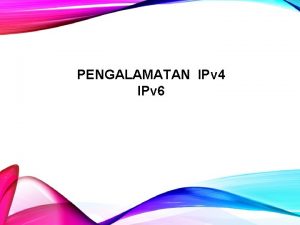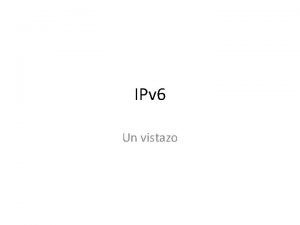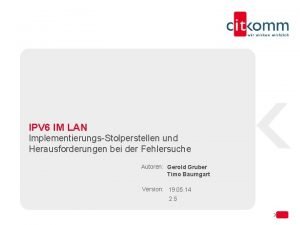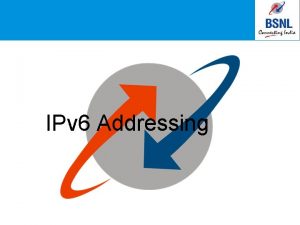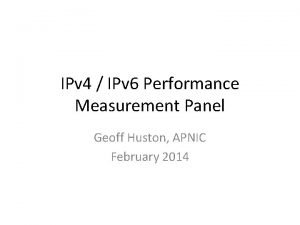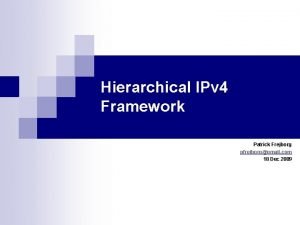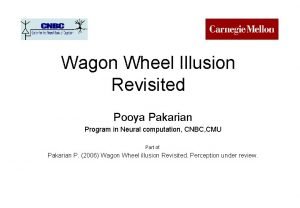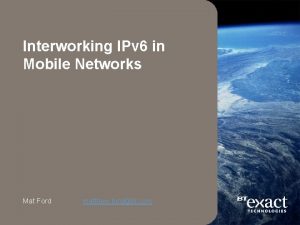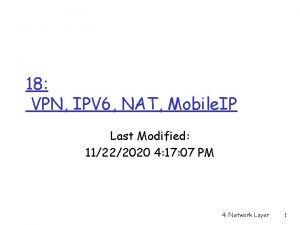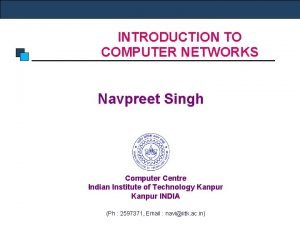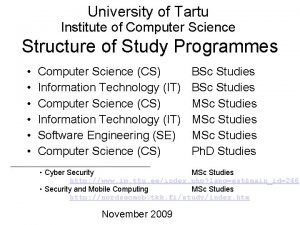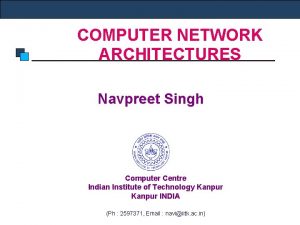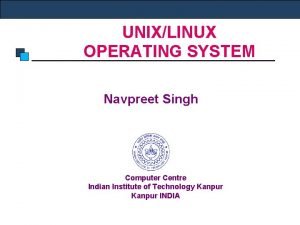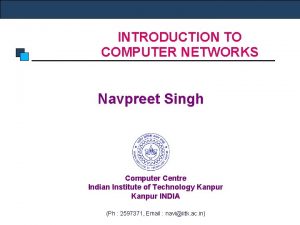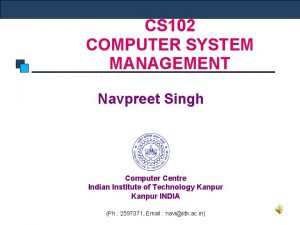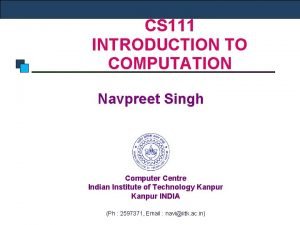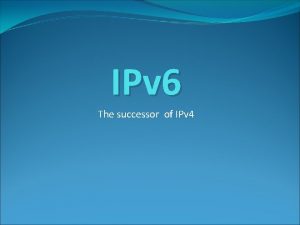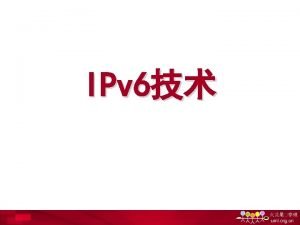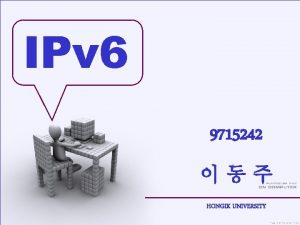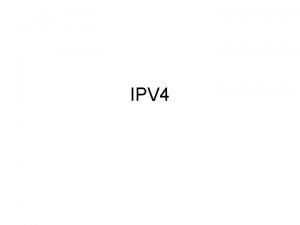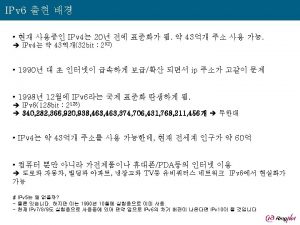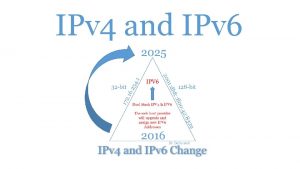IPv 6 Navpreet Singh Computer Centre Indian Institute
















![IPv 6 Address Example [root@vsnlproxy ~]# ifconfig eth 0 Link encap: Ethernet HWaddr 00: IPv 6 Address Example [root@vsnlproxy ~]# ifconfig eth 0 Link encap: Ethernet HWaddr 00:](https://slidetodoc.com/presentation_image/39f4100cba460152e99baf263e17e90d/image-17.jpg)










































- Slides: 59

IPv 6 Navpreet Singh Computer Centre Indian Institute of Technology Kanpur INDIA (Ph : 2597371, Email : navi@iitk. ac. in)

About Myself I am Principal Computer Engineer at IIT Kanpur and I manage the Campus Network and Internet Services of IITK. IIT Kanpur has one of the largest networks in the country. IITK Campus Network now has more than 15000 nodes providing connectivity to more than 6000 users in Academic Departments, Student Hostels and Residences. IITK has 1 Gbps Internet Connectivity. All application servers (Mail, DNS, Proxy Caching, Web etc. ) are maintained in-house. B. Tech (1990) and M. Tech (1996) from IIT Kanpur Working in IIT Kanpur for more than 17 years

IPv 6 Why IPv 6? Shortage of IPv 4 addresses Internet is expanding very rapidly in developing countries like India, China New devices like phones need IP address End-to-End Reachability is not possible without IPv 6 New Features like Autoconfiguration, better support for Qo. S, Mobility and Security, Route Aggregation, Jumbo Frames

IPv 6 Address IPv 4: 32 bits or 4 bytes long 4, 200, 000 possible addressable nodes • IPv 6: 128 bits or 16 bytes • 3. 4 * 1038 possible addressable nodes • 340, 282, 366, 920, 938, 463, 374, 607, 432, 768, 211, 456 • 5 * 1028 addresses person

IPv 6 Header Format IPv 4: 20 Bytes + Options IPv 6: 40 Bytes + Extension Header IPv 4 Header Version IHL Type of Service Identification Time to Live Protocol IPv 6 Header Total Length Flags Fragment Offset Header Checksum Version Traffic Class Payload Length Flow Label Next Header Hop Limit Source Address Destination Address Options Padding Source Address Destination Address

IPv 6 Address Types Unicast Address is for a single interface. IPv 6 has several types (for example, global and IPv 4 mapped). Multicast One-to-many Enables more efficient use of the network Uses a larger address range Anycast One-to-nearest (allocated from unicast address space). Multiple devices share the same address. All anycast nodes should provide uniform service. Source devices send packets to anycast address. Routers decide on closest device to reach that destination. Suitable for load balancing and content delivery services.

IPv 6 Address Scope Link-local: The scope is the local link (nodes on the same subnet) Unique-local: The scope is the organization (private site addressing) Global: The scope is global (IPv 6 Internet addresses)

IPv 6 Address Representation x: x: x, where x is a 16 -bit hexadecimal field Leading zeros in a field are optional: 2031: 0: 130 F: 0: 0: 9 C 0: 876 A: 130 B Successive fields of 0 can be represented as : : , but only once per address. Examples: 2031: 0000: 130 F: 0000: 09 C 0: 876 A: 130 B 2031: 0: 130 f: : 9 c 0: 876 a: 130 b FF 01: 0: 0: 0: 1 >>> FF 01: : 1 0: 0: 1 >>> : : 1 0: 0: 0 >>> : :

IPv 6 Address Representation: Link Local Hosts on the same link (the same subnet) use these automatically configured addresses to communicate with each other. Neighbor Discovery provides address resolution. The prefix for link-local addresses is FE 80: : /64. The following illustration shows the structure of a link-local address.

IPv 6 Address Representation: Unique Local IPv 6 unicast unique-local addresses are similar to IPv 4 private addresses. The scope of a unique-local address is the internetwork of an organization’s site. (You can use both global addresses and unique-local addresses in your network) The prefix for unique-local addresses is FC 00: : /8.

IPv 6 Address Representation: Link Local Remaining 54 bits Mandatory address for communication between two IPv 6 devices Automatically assigned by router as soon as IPv 6 is enabled

IPv 6 Address Representation: Global Unicast Global unicast and anycast addresses are defined by a global routing prefix, a subnet ID, and an interface ID.

IPv 6 Address Representation EUI 64 IPv 6 uses the extended universal identifier (EUI)64 format to do stateless autoconfiguration. This format expands the 48 -bit MAC address to 64 bits by inserting “FFFE” into the middle 16 bits. To make sure that the chosen address is from a unique Ethernet MAC address, the universal/local (U/L bit) is set to 1 for global scope (0 for local scope).

IPv 6 Address Representation EUI 64

IPv 6 Stateless Autoconfiguration Stateless Address Configuration (IP Address, Default Router Address) Routers sends periodic Router Advertisement Node gets prefix information from the Router advertisement and generates the complete address using its MAC address Global Address=Link Prefix + EUI 64 Address Router Address is the Default Gateway

IPv 6 Stateless Autoconfiguration Example MAC address: 00: 0 E: 0 C: 31: C 8: 1 F EUI 64 Address: 20 E: 0 CFF: FE 31: C 81 F Router Solicitation is sent on FF 01: : 2 (All Router Multicast Address) and Advertisement sent on FF 01: : 1 (All Node Multicast Address)
![IPv 6 Address Example rootvsnlproxy ifconfig eth 0 Link encap Ethernet HWaddr 00 IPv 6 Address Example [root@vsnlproxy ~]# ifconfig eth 0 Link encap: Ethernet HWaddr 00:](https://slidetodoc.com/presentation_image/39f4100cba460152e99baf263e17e90d/image-17.jpg)
IPv 6 Address Example [root@vsnlproxy ~]# ifconfig eth 0 Link encap: Ethernet HWaddr 00: 18: 71: E 5: 47: 82 inet addr: 172. 31. 1. 227 Bcast: 172. 31. 255 Mask: 255. 0. 0 inet 6 addr: 2001: df 0: 92: 0: 218: 71 ff: fee 5: 4782/64 Scope: Global inet 6 addr: fe 80: : 218: 71 ff: fee 5: 4782/64 Scope: Link

IPv 6 DHCPv 6 Stateful Configuration Provides not only IP address, also other configuration parameters like DNS

IPv 6 DHCPv 6 Client Initiates requests on a link to obtain configuration parameters use its link local address to connect the server Send requests to FF 02: : 1: 2 multicast address (All_DHCP_Relay_Agents_and_Servers) Relay Agent/ DHCPv 6 Server node that acts as an intermediary to deliver DHCP messages between clients and servers is on the same link as the client Is listening on multicast addresses: All_DHCP_Relay_Agents_and_Servers (FF 02: : 1: 2)

IPv 6 Routing in IPv 6 Same Protocols as in IPv 4 Static RIPng OSPFv 3 MP-BGP 4 q. Use ping 6 and traceroute 6 commands to check reachability and route

IPv 6 Routing in IPv 6 Aggregation of prefixes announced in the global routing table Efficient and scalable routing

IPv 6 Neighbor Discovery IPv 6 nodes which share the same physical medium (link) use Neighbor Discovery (NDP) to: Discover their mutual presence Determine link-layer addresses of their neighbors (equivalent to ARP) Find routers Maintain neighbors’ reachability information Uses Multicast Address

IPv 6 Neighbor Discovery Protocol features: Router discovery Prefix(es) discovery Parameters discovery (link MTU, Max Hop Limit, . . . ) Address auto-configuration Address resolution Next Hop determination Neighbor Unreachability Detection Duplicate Address Detection Redirect

IPv 6 Neighbor Discovery It provides the functionality of: ARP ICMP redirect

IPv 6 Neighbor Discovery ND specifies 5 types of ICMP packets: Router Advertisement (RA) : Periodic advertisement (of the availability of a router) which contains: » list of prefixes used on the link (autoconf) » a possible value for Max Hop Limit (TTL of IPv 4) » value of MTU Router Solicitation (RS) : The host needs RA immediately (at boot time)

IPv 6 Neighbor Discovery Neighbor Solicitation (NS): » to determine the link-layer address of a neighbor » or to check its reachability » also used to detect duplicate addresses (DAD) Neighbor Advertisement (NA): » answer to a NS packet » to advertise the change of physical address Redirect: » Used by a router to inform a host of a better route to a given destination

Transition to IPv 6 Navpreet Singh Computer Centre Indian Institute of Technology Kanpur INDIA (Ph : 2597371, Email : navi@iitk. ac. in)

IPv 6 Transition Mechanism No fixed day to convert; no need to convert all at once. Transition Options: Dual Stack IPv 6 -IPv 4 Tunnel IPv 6 -IPv 4 Translation

IPv 6 Transition Mechanism

IPv 6 6/4 Dual Stack Hosts and Network This allows all the end hosts and intermediate network devices (like routers, switches, modems etc. ) to have both IPv 4 and IPv 6 addresses and protocol stack. If both the end stations support IPv 6, they can communicate using IPv 6; otherwise they will communicate using IPv 4. This will allow both IPv 4 and IPv 6 to coexist and slow transition from IPv 4 to IPv 6 can happen.

IPv 6 6/4 Dual Stack Hosts and Network

IPv 6 6/4 Dual Stack Hosts and Network IITK_KNPR_CMTR_DIA#sh run Building configuration. . . interface Gigabit. Ethernet 0/1 description Connected to IITK ip address 203. 197. 196. 18 255. ipv 6 address 2001: DF 0: 92: : 1/64 ipv 6 enable ! interface Gigabit. Ethernet 0/2 description Airtel IPv 6 Connectivity ip address 59. 144. 72. 85 255. 2 ipv 6 address 2404: A 800: 2: D: : 2/64 ipv 6 enable !

IPv 6 Tunneling IP 6 via IP 4 This allows encapsulating IPv 6 packets in IPv 4 packets for transport over IPv 4 only network. This will allow IPv 6 only end stations to communicate over IPv 4 only networks.

IPv 6 IP 6 -IP 4 Translation This allows communication between IPv 4 only and IPv 6 only end stations. The job of the translator is to translate IPv 6 packets into IPv 4 packets by doing address and port translation and vice versa.

IPv 6 Current Status of IPv 6 Deployment

IPv 6 What, When and How to Migrate All the major Operating Systems support IPv 6. Most of the new network equipment supports IPv 6 either by default or is available as an upgrade. Countries like US, France, Canada, Japan, China, and South Korea etc. have taken a lead in IPv 6 deployment. The government in these countries have strongly promoted the use of IPv 6 and also mandated the support of IPv 6 by all equipment manufacturers and suppliers and service providers. China has launched China Next Generation Internet (CNGI) which is based on IPv 6. China also showcased IPv 6 readiness in the Beijing 2008 Olympics. IT IS TIME FOR INDIA TO ACT

IPv 6 Migration Steps 1. Check IPv 6 compliance: Study the existing network and verify that all the equipment installed supports IPv 6. Recommend upgrade of the equipment which does not support software upgrade or hardware upgrade/replacement. All future equipment purchase must ensure that the equipment is IPv 6 compatible.

IPv 6 Migration Steps 2. Plan IPv 6 addressing: Take IPv 6 addresses from the Regional Internet Registry (APNIC in case of India) or upstream Internet provider. Make IPv 6 Address allocation policy and plan IPv 6 addressing for the entire network.

IPv 6 Migration Steps 3. Enable IPv 6 Routing: Enable IPv 6 routing in the entire network. For organization LANs, this would require IPv 6 address configuration in all Layer 3 switches and routers and enable static/ dynamic routing. In case of Service provider networks, this would require configuring Provider Edge (PE) Routers as 6 PE to support IPv 6 over MPLS (Multi Protocol Label Switching) backbone, enabling IPv 6 routing in the Customer Edge (CE) Router or Customer Premise Equipment (CPE) to connect the customer network over IPv 6 and enabling BGP (Border Gateway Protocol) routing over IPv 6 with the upstream providers to provide Internet access over IPv 6. The IPv 6 routes to customer networks may be static or BGP

IPv 6 Migration Steps 4. Setup IPv 6 Application Servers: Upgrade the Domain Name servers to support IPv 6 address resolution. Other servers like Web servers, Mail servers, Network Management servers, Authentication/ AAA servers etc. can also be upgraded to support IPv 6.

IPv 6 Migration Steps 5. Enable IPv 6 Peering: Enable IPv 6 peering with upstream Internet providers. Service Providers need to enable IPv 6 peering with other ISPs (Internet Service Providers) also through Internet Exchange (NIXI in case of India).

IPv 6 Migration Steps 6. Migrate Services on IPv 6: Test various services like Internet access, Email, Vo. IP, IPTv etc. on IPv 6 and migrate the services to support both IPv 6 and IPv 4. Service Providers should test and migrate their services like Internet Leased Line, VPN, Broadband, Multiplay, and Mobile etc. to support both IPv 6 and IPv 4.

IPv 6 Qo. S Navpreet Singh Computer Centre Indian Institute of Technology Kanpur INDIA (Ph : 2597371, Email : navi@iitk. ac. in)

About Myself I am Principal Computer Engineer at IIT Kanpur and I manage the Campus Network and Internet Services of IITK. IIT Kanpur has one of the largest networks in the country. IITK Campus Network now has more than 15000 nodes providing connectivity to more than 8000 users in Academic Departments, Student Hostels and Residences. IITK has three 1 Gbps Internet Connectivity. All application servers (Mail, DNS, Proxy Caching, Web etc. ) are maintained in-house. B. Tech (1990) and M. Tech (1996) from IIT Kanpur Working in IIT Kanpur for more than 17 years

IPv 6 Security Navpreet Singh Computer Centre Indian Institute of Technology Kanpur INDIA (Ph : 2597371, Email : navi@iitk. ac. in)

About Myself I am Principal Computer Engineer at IIT Kanpur and I manage the Campus Network and Internet Services of IITK. IIT Kanpur has one of the largest networks in the country. IITK Campus Network now has more than 15000 nodes providing connectivity to more than 8000 users in Academic Departments, Student Hostels and Residences. IITK has 1 Gbps Internet Connectivity. All application servers (Mail, DNS, Proxy Caching, Web etc. ) are maintained in-house. B. Tech (1990) and M. Tech (1996) from IIT Kanpur Working in IIT Kanpur for more than 17 years

IPv 6 Security IPv 4 was not designed with security in mind. Packet Sniffing: Due to network topology, IP packets sent from a source to a specific destination can also be read by other nodes, which can then get hold of the payload (for example, passwords or other private information). IP Spoofing: IP addresses can be very easily spoofed both to attack those services whose authentication is based on the sender’s address (as the rlogin service or several WWW servers). Connection Hijacking: Whole IP packets can be forged to appear as legal packets coming from one of the two communicating partners, to insert wrong data in an existing channel.

IPv 6 Security In IPv 4, Security is implemented in: Applications – HTTPS, IMAPS, SSH etc. IPsec tunnels

IPv 6 Security in IPv 6 IPv 4 - NAT breaks end-to-end network security IPv 6 - Huge address range – No need of NAT

IPv 6 Security in IPv 6 Reconnaissance In IPv 6: Default subnets in IPv 6 have 264 addresses Scan with 10 Mpps will take more than 50 000 years Ping sweeps on IPv 6 networks are not possible

IPv 6 Security in IPv 6 Viruses and Worms In IPv 6: Viruses and Email, IM worms: IPv 6 brings no change. Other worms: IPv 4: reliance on network scanning IPv 6: not so easy Worm developers will adapt to IPv 6 IPv 4 best practices around worm detection and mitigation remain valid. IPS systems and Anti-viruses will not change.

IPv 6 IPsec Applies to both IPv 4 and IPv 6: – Mandatory for IPv 6 – Optional for IPv 4 Applicable to use over LANs, across public & private WANs, & for the Internet IPSec is a security framework – Provides suit of security protocols – Secures a pair of communicating entities –Two different modes: Transport mode (host-to host) and Tunnel Mode (Gateway-to-Gateway or Gateway-to-host)

IPv 6 IPsec Protocol Services Provided by IPsec Authentication – ensure the identity of an entity (integrity) and replay protection Confidentiality – protection of data from unauthorized disclosure Key Management – generation, exchange, storage, safeguarding, etc. of keys in a public key cryptosystem

IPv 6 IPsec Protocol IPsec Services Authentication: AH (Authentication Header - RFC 4302) Confidentiality: ESP (Encapsulating Security Payload - RFC 4303) Key management: IKEv 2 (Internet Key Exchange - RFC 4306) When two computers (peers) want to communicate using IPSec, they mutually authenticate with each other first and then negotiate how to encrypt and digitally sign traffic they exchange. These IPSec communication sessions are called security associations (SAs).

IPv 6 IPsec Protocol IPsec Services S-HTTP S/MIME TCP IP Application approach HTTP FTP SMTP TCP AH ESP IP Network approach

IPv 6 IPsec Protocol IPsec AH IPv 6 AH Packet Format IPv 6 Header Hop-by-Hop Authentication Higher Level Other Headers Routing Header Protocol Data IPv 6 AH Header Format Next Header Length Reserved Security Parameters Index Authentication Data (variable number of 32 -bit words)

IPv 6 IPsec Protocol IPsec ESP Format Security Parameters Index (SPI) Initialization Vector (optional) Replay Prevention Field (incrementing count) Payload Data (with padding) Authentication checksum

IPv 6 IPsec Protocol Implementations Linux-kernel 2. 6. x onwards Cisco IOS-12. 4(4)T onwards Windows Vista onwards

IPv 6 Security Issues in IPv 6 IPsec Key Exchange Protocol not yet fully Standardized Scanning possible – If IP address assignment is poorly designed No protection against all denial of service attack (Do. S attacks difficult to prevent in most cases) No many firewalls in market with V 6 capability
 Navpreet singh iit kanpur
Navpreet singh iit kanpur Raj birk
Raj birk Zhaunagush meaning
Zhaunagush meaning Indian institute of space science and technology
Indian institute of space science and technology E learning agriculture portal
E learning agriculture portal Center of gravity statics
Center of gravity statics Centroid of wire
Centroid of wire Ipv meaning
Ipv meaning Ipv 4 terdiri dari... *
Ipv 4 terdiri dari... * Ipv format
Ipv format Ipv 4 terdiri dari...
Ipv 4 terdiri dari... Ipv bits
Ipv bits Voith насос voith ipva, ipvap
Voith насос voith ipva, ipvap Ipv vs dv
Ipv vs dv Ipv meaning
Ipv meaning Ipv foo
Ipv foo Modelo de ipv en cuba
Modelo de ipv en cuba Ping ipv
Ping ipv Ipv 4 terdiri dari... *
Ipv 4 terdiri dari... * Ipv 4 terdiri dari... *
Ipv 4 terdiri dari... * Ipv protocol
Ipv protocol 1035504
1035504 Polio ddt vergiftung
Polio ddt vergiftung Ipv route
Ipv route Ipv v4
Ipv v4 Ipv 6
Ipv 6 Ipv route
Ipv route Ipv refresher course
Ipv refresher course Ipv carve out
Ipv carve out Apa itu iptv
Apa itu iptv Ipv format
Ipv format Ipv format
Ipv format Ipv finance
Ipv finance Ipv route
Ipv route Ipv to psd
Ipv to psd Ipv
Ipv Ipv format
Ipv format Ipv
Ipv Ipv erfahrungen
Ipv erfahrungen Ipv header
Ipv header Ipv
Ipv Vaccination dose
Vaccination dose Ipv allianz
Ipv allianz Frejborg loka
Frejborg loka Ipv cnbc
Ipv cnbc Rpv ecommerce
Rpv ecommerce Relaciona los nombres con las posiciones.
Relaciona los nombres con las posiciones. Ipv streaming
Ipv streaming Intranet ipv
Intranet ipv Bt smar
Bt smar Classful subnetting
Classful subnetting Ipv vpn
Ipv vpn Introduction computer centre
Introduction computer centre Hkuportal
Hkuportal Iya abubakar computer centre abu zaria
Iya abubakar computer centre abu zaria The computer ethics institute
The computer ethics institute Computer institute in hinjilicut
Computer institute in hinjilicut Institute of computer science university of tartu
Institute of computer science university of tartu Ten commandments of computer ethics
Ten commandments of computer ethics Sandeep singh jolly
Sandeep singh jolly
